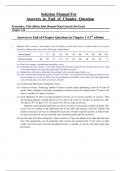Exam (elaborations)
Answers to End of Chapter Questions Solution Manual For Economics, 11th Edition by John Sloman Dean Garratt Jon Guest
Answers to End of Chapter Questions Solution Manual For Economics, 11th Edition by John Sloman Dean Garratt Jon Guest
[Show more]



